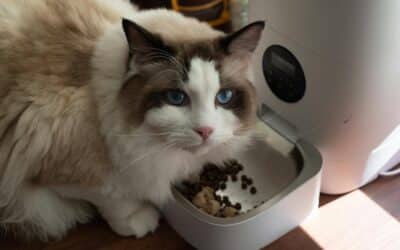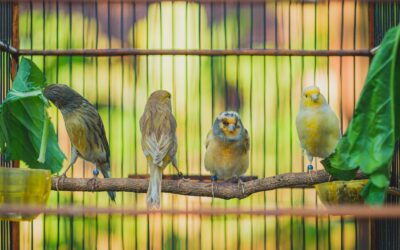If you’re thinking of adding a dog, cat, or other pet to your family but you’re also a plant lover, it’s a good idea to check whether any of the houseplants you grow are toxic to pets. The same applies when you bring home a new plant and aren’t sure about its toxicity—there are many houseplants out there that are toxic to dogs and cats, including some of the most popular species.
Which plants are toxic? Let’s find out below!
To keep in mind
Although there are many houseplants that are toxic to dogs and cats, very few are likely to actually cause serious issues. The really dangerous ones are mostly outdoor species (castor bean plant, oleander, foxglove, trumpet flower, etc.) or used as cut flowers (true lilies from the genus Lilium). Still, ingestion of many of the houseplants on this list can cause significant discomfort, so it’s still absolutely best practice to keep your pet away from it.
You’ll notice there are a lot of houseplants that contain calcium oxalate crystals. These needle-like microscopic crystals cause irritation, which results in symptoms like swelling, drooling, and rashes, which can be combated with ample water. Most oxalate crystal-containing plants belong to the aroid family, Araceae, which are all toxic. However, there’s only one in this category that you really have to look out for, and that’s the dumb cane (discussed at the top of the list).
We’ve marked severely toxic plants like the dumb cane with an ☣️ emoji. You’ll notice we like to refer to plants’ scientific names; this is because common names can be confusing, used for multiple plants, or vary by region.
[divilifeshortcode id='7986']
PS: This list is non-exhaustive. If you know the specific name of a plant and want to know more about its toxicity, you can check the ASPCA website. You can also check the plant against our list of houseplants that are safe for pets.
Houseplants that are toxic to dogs & cats
☣️ Dumb cane (Dieffenbachia)
Common species: Dieffenbachia seguine, Dieffenbachia amoena
Toxin: Calcium oxalate crystals
Severity: Severe, call your veterinarian
Note: This plant’s common name is “dumb cane” because the swelling resulting from the sap touching the mucus membranes is said to make one unable to talk. Out of the calcium oxalate crystal-containing houseplants, this one’s the most severe.

Dieffenbachia seguine
Philodendron
Common houseplants: Heartleaf Philodendron (Philodendron hederaceum), blushing Philodendron (Philodendron erubescens), silver sword (Philodendron hastatum) & many, many more
Severity: Low to moderate
Toxin: Calcium oxalate crystals
Notes: There are hundreds of different Philodendron species out there, not to mention cultivars. All contain the same irritating sap in all their parts.

Philodendron ‘Birkin’
Swiss cheese plant (Monstera)
Common houseplants: Split-leaf Philodendron (Monstera deliciosa), Swiss cheese vine (Monstera adansonii)
Severity: Low to moderate
Toxin: Calcium oxalate crystals
Notes: The very similar-looking plants of the genus Thaumatophyllum also belong to the aroid family and are therefore similarly toxic.

Monstera deliciosa
Elephant ear (Alocasia)
Common houseplants: Zebra plant (Alocasia zebrina), giant taro (Alocasia macrorrhizos), Asian taro (Alocasia odora), African mask plant (Alocasia × amazonica) & many more
Severity: Moderate
Toxin: Calcium oxalate crystals
Notes: Some Alocasia plants are actually consumed by humans, but only when thoroughly cooked. Cases of poisoning have happened, especially when people eat the corm (root stock) raw, but death is luckily still very unlikely in both humans and pets.

Alocasia cuprea
Elephant ear (Caladium)
Common houseplants: Angel’s wings (Caladium bicolor)
Severity: Low to moderate
Toxin: Calcium oxalate crystals
Notes: There are many fantastically colored and patterned varieties of Caladium out there, but you should keep them away from your pets to prevent issues due to insoluble calcium oxalate crystals. And yes, they have the same common name as the aforementioned genus, Alocasia!

Caladium bicolor
Arrowhead plant (Syngonium)
Common houseplants: Goosefoot (Syngonium podophyllum), Syngonium erythrophyllum
Severity: Low to moderate
Toxin: Calcium oxalate crystals
Notes: The genus name “Syngonium” is often used to refer specifically to Syngonium podophyllum, which is by far the most popular as a houseplant.

Syngonium podophyllum
Snake plant (Sansevieria)
Common houseplants: Mother-in-law’s tongue (Sansevieria trifasciata), whale fin (Sansevieria masoniana), cylindrical snake plant (Sansevieria cylindrica) & many more
Severity: Low to moderate
Toxin: Saponins
Notes: Technically, the plants in the genus Sansevieria have been moved to Dracaena. However, they’re still commonly referred to by their old name, so we’re doing the same here to avoid confusion.

Sansevieria trifasciata
Peace lily (Spathiphyllum)
Common houseplants: Peace lily (Spathiphyllum wallisii), various hybrids
Severity: Low to moderate
Toxin: Calcium oxalate crystals
Notes: Despite its confusing common name, this is NOT a true lily. As such, it’s not nearly as dangerous as flowers of the genus Lilium. However, the sap does still cause irritation to the mouth, throat, and gastrointestinal system if ingested.

Spathiphyllum wallisii
Anthurium
Common houseplants: Flamingo plant (Anthurium andraeanum), Anthurium clarinervium & many more
Severity: Low to moderate
Toxin: Calcium oxalate crystals
Notes: The colorful flowers of the popular flamingo plant are extra-attractive to children, which should be kept away from them just like our pets. Chewing the leaves or flowers can cause nasty irritation in the mouth and throat for both humans and animals.

Anthurium andraeanum
Begonia
Common houseplants: Painted-leaf Begonia (Begonia rex), polka dot plant (Begonia maculata) and many (so many!) more.
Severity: Low
Toxin: Calcium oxalate crystals
Notes: Most of the irritating insoluble calcium oxalate in a Begonia is located in the roots, meaning it’s usually out of reach of our furry friends. If your pet takes a nibble from the leaves, the damage is usually limited to irritated mucus membranes. Offer plenty of water!

Begonia rex
Dragon tree (Dracaena)
Common houseplants: Madagascar Dragon tree (Dracaena reflexa var. marginata), corn plant (Dracaena fragrans), lucky bamboo (Dracaena sanderiana) & many more
Severity: Low to moderate
Toxin: Saponins
Note: Plants formerly classified as Sansevieria are now in this genus. Dragon trees are among the most common houseplants of all time.

Dracaena fragrans
Croton plant (Codiaeum)
Common houseplants: Codiaeum variegatum
Severity: Moderate
Toxin: Diterpene esters (5-deoxyingenol)
Notes: The berries are especially toxic and ingestion of any part can cause diarrhea. The milky sap is quite irritating to the skin, so wash it off immediately.

Codiaeum variegatum
Chinese evergreen (Aglaeonema)
Common houseplants: Poison dart plant (Aglaonema commutatum)
Severity: Low to moderate
Toxin: Calcium oxalate crystals
Notes: This one comes in so many different colors that it can be difficult to tell they’re actually Aglaonemas. If you see a houseplant with lots of striping, pink coloration, and the like, it’s likely one of these.

Fancy Aglaeonema cultivar
☣️ Kalanchoe
Common houseplants: Florist’s Kalanchoe (Kalanchoe blossfeldiana), panda plant (Kalanchoe tomentosa), mother of thousands (Kalanchoe daigremontiana), felt bush (Kalanchoe beharensis) & many more
Severity: High
Toxin: Cardiac glycosides
Note: In South Africa and Australia, cattle are commonly accidentally poisoned by Kalanchoe plants growing in pastures. Just keep this one away from your pets!

Kalanchoe blossfeldiana
Mini Monstera (Rhaphidophora)
Common houseplants: Mini Monstera (Rhaphidophora tetrasperma), dragon tail (Rhaphidophora decursiva)
Severity: Low to moderate
Toxin: Calcium oxalate crystals
Notes: This vining plant is often confused with true Monstera plants, and their toxicity is similar.

Rhaphidophora tetrasperma
☣️ Cycas
Common houseplants: Sago palm (Cycas revoluta)
Severity: Very severe, call your veterinarian
Toxin: Glucosides (Cycasin)
Notes: One study mentions a 30% mortality rate for Cycas poisoning, with dogs appearing particularly susceptible. This isn’t a “place on a high shelf away from your pet” plant, but rather a solid case of “do not let it enter your house at all, ever”.

Cycas revoluta
Scindapsus
Common houseplants: Satin Pothos/silver Philodendron (Scindapsus pictus)
Severity: Low to moderate
Toxin: Calcium oxalate crystals
Notes: Although it’s often called a Pothos, and the actual Pothos plant used to be classified as a Scindapsus, they’re actually two different things (see below). Their toxicity is pretty much the same, though.

Scindapsus pictus
Pothos, devil’s ivy (Epipremnum)
Common houseplants: Pothos (Epipremnum aureum), Epipremnum pinnatum
Severity: Low to moderate
Toxin: Calcium oxalate crystals
Notes: By far the most common member of the genus Epipremnum to be grown as a houseplant is the pothos plant. It comes in different colors, not just the typical green and gold, so keep an eye out for it.

Epipremnum aureum ‘Neon’
☣️ Cyclamen
Common houseplants: Persian Cyclamen (Cyclamen persicum)
Severity: Severe, call your veterinarian
Toxin: Saponins
Note: Serious issues are unlikely if your pet nibbled on the leaves or flowers. However, if it got into the highly toxic tuber somehow, you should act fast.

Cyclamen persicum
ZZ plant (Zamioculcas zamiifolia)
Severity: Low to moderate
Toxin: Calcium oxalate crystals
Note: The only member of its genus, the ZZ plant doesn’t look much like an aroid, but it is—hence the insoluble calcium oxalate crystals.

Zamioculcas zamiifolia
Ivy (Hedera)
Common houseplants: English ivy (Hedera helix)
Severity: Moderate
Toxin: Triterpenoid saponins
Note: True ivy plants (Hedera sp.) don’t just cause gastrointestinal symptoms like vomiting, but can also result in nasty skin irritation.

Hedera helix
Spurge (Euphorbia)
Common houseplants: Poinsettia (Euphorbia pulcherrima), African milk tree (Euphorbia trigona), crown of thorns plant (Euphorbia milii) & many more
Severity: Moderate
Toxin: Diterpenes
Notes: The most famous member of the genus Euphorbia, the poinsettia plant, has long been considered extremely dangerous to pets. Luckily, it’s not actually as bad as many people think, although it’s still best to place yours on a high shelf away from your furry friends. Euphorbia sap is damaging to the skin and especially the eyes.

Euphorbia pulcherrima
Fig tree (Ficus)
Common houseplants: Fiddle leaf fig (Ficus lyrata), weeping fig (Ficus benjamina), rubber tree (Ficus elastica) & more
Severity: Low
Toxin: Proteolytic enzyme (ficin)
Notes: The milky white sap is irritating to the skin and can cause gastrointestinal upset.

Ficus elastica
Conclusion
If you think your pet has ingested a toxic houseplant, you check the plant species against this list. Try to figure out how much they ate; some plants, like those containing saponins, are very bitter. This means that, with some luck, they gave up after a bite or two. In any case, monitor your furry friend very closely and offer plentyof water to dilute any toxins and relieve irritation.
Call your veterinarian if you see changes in your pet’s behavior, or if they ingested a plant whose toxicity is marked as “severe”. In fact, you can always give them a ring if you’re worried—they’ll tell you whether they’d like you to bring the animal in for a check-up or whether you can manage any symptoms at home.
Bertero, A., Fossati, P., & Caloni, F. (2020). Indoor companion animal poisoning by plants in Europe. Frontiers in veterinary science, 7, 487.







